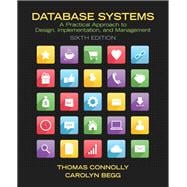Database Systems is ideal for a one- or two-term course in database management or database design in an undergraduate or graduate level course. With its comprehensive coverage, this book can also be used as a reference for IT professionals.
This best-selling text introduces the theory behind databases in a concise yet comprehensive manner, providing database design methodology that can be used by both technical and non-technical readers. The methodology for relational Database Management Systems is presented in simple, step-by-step instructions in conjunction with a realistic worked example using three explicit phases—conceptual, logical, and physical database design.
¿
Teaching and Learning Experience
This program presents a better teaching and learning experience–for you and your students. It provides:
- Database Design Methodology that can be Used by Both Technical and Non-technical Readers
- A Comprehensive Introduction to the Theory behind Databases
- A Clear Presentation that Supports Learning










